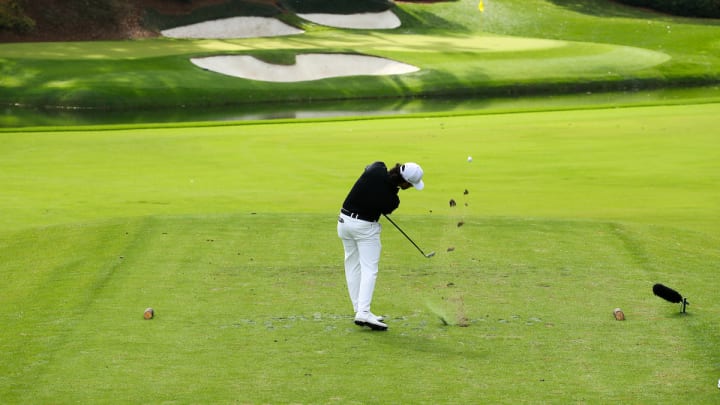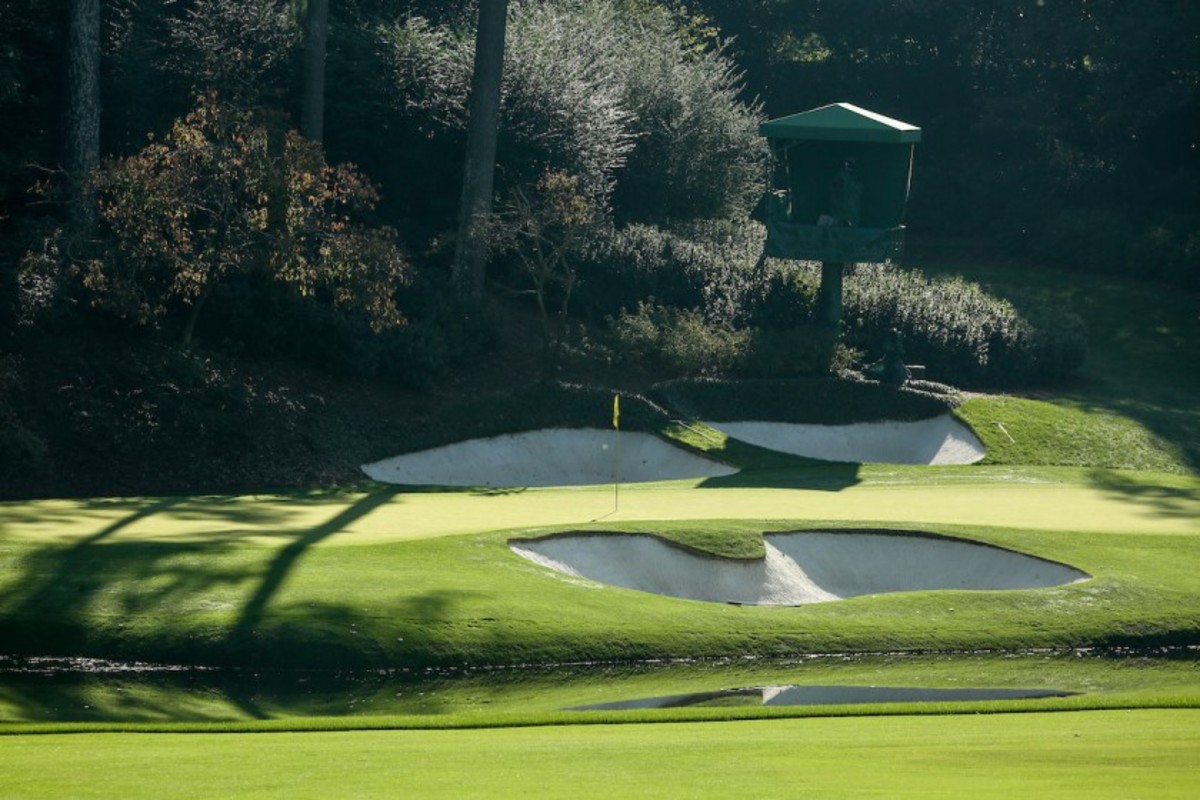Masters 12th Hole: Stats, History, Memorable Moments From Augusta National’s Par-3 ‘Golden Bell’

A closer look at Augusta National Golf Club's 12th hole for this year’s Masters:
Name: Golden Bell
Par: 3
2022 yardage: 155
1934 yardage: 150
2021 scoring average: 3.11
All-time scoring average: 3.27
All-time difficulty rank: 4
Lowest year: 3.03 (2002)
Highest year: 3.55 (1966)
THE LAYOUT
Situated in the heart of Amen Corner, the shortest of Augusta National Golf Club’s 18 holes may also be its most vexing. The hole plays to a hair over 150 yards, but there are numerous factors to weigh during club selection. From above, the wide and narrow green resembles a shoe’s sole and is roughly 60 feet at its greatest depth. The putting surface slopes from back to front and is fortified on the front side by Rae’s Creek flashing diagonally across the green’s width, a bunker guarding the green’s mid-section and a steep embankment protecting the green’s front right. On the backside there are two strategically placed bunkers. Then there’s the wind, which could cause up to a four-club differential based on the direction and speed. Jack Nicklaus, a six-time Masters champion, has said of the 12th: “Sometimes I get there, and my hands just shake.”
SIGNIFICANT CHANGES
1951: Green extended to right by 18 feet.
1958: Ben Hogan Bridge dedicated.
1960: Green raised.
1965: Tees revised to split level, side-by-side.
Notes: The 12th is perhaps the most natural and least changed hole on the course. … The green is believed to have been constructed on an Indian burial ground. … In 1981, a heating and cooling system was installed beneath the green’s surface to offset Georgia’s summer heat and winter frost.
RELATED: Augusta’s fiendish 12th rewrites history

MASTERS MOMENTS
The iconic Ben Hogan Bridge, dedicated in 1958 to recognize the Texan’s then-record score of 274 in 1953, serves as a walkway across Rae’s Creek to the green. … There have been three aces made on this hole during Masters competition: Claude Harmon, 1947 (7-iron, 155 yards); William Hyndman, 1959 (6-iron, 155 yards); and Curtis Strange, 1988 (7-iron, 155 yards). … The tales often spoken about the 12th hole more often are about carnage than celebration. In 1952, Gene Sarazen played Augusta National’s front nine in 1 under par. At the 12th, he hit three balls into the creek, recorded an 8 and then withdrew from the tournament.
In 1959, Arnold Palmer went to the 12th hole with a two-stroke lead, made a triple-bogey 6 and failed to complete an attempt at successive Masters titles. … In 1980, Tom Weiskopf produced the hole’s worst score, a 13 that included five golf balls finding Rae’s Creek. Years later, Weiskopf shared a light-hearted story with Golf Digest: “You know, I had never hit a ball into Rae’s Creek until that time. I had hit a ball into Rae’s Creek from behind the green on my second shot, but never the tee.”
In 2016, Jordan Spieth held the final-round lead standing on the 12th tee. Spieth, looking to join Jack Nicklaus, Nick Faldo and Tiger Woods as the Masters’ only back-to-back champions, was coming off bogeys at the 10th and 11th holes. He only made matters worse with a quadruple-bogey 7 at the 12th. In a span of three holes, Spieth went from holding a five-stroke lead to trailing by three strokes.
In November’s Masters, Tiger Woods, a five-time champion, recorded a 10 in Sunday’s final round. The score was Woods’ worst ever on the PGA Tour. His problems began by misjudging the wind. “I committed to the wrong wind. The wind was off the right for the first two guys [in Woods’ pairing], and then when I stepped up there, it switched to howling off the left.” … Not all is lost at the 12th, though. In 1992, Fred Couples received a reprieve from the shaved bank fronting the green. Rains from the previous day may have softened the sloped turf, because when Couples’ 8-iron approach hit the bank, the ball did not immediately roll back into Rae’s Creek. Instead, the ball crept slowly backward and stopped inches away from the water. Couples managed to get up and down for par and went on to win his only green jacket, by two strokes over Raymond Floyd.
MASTERS MEMORY
1958: Arnold Palmer held a one-stroke, final-round lead over Ken Venturi when the pair reached the 12th hole. Palmer’s 7-iron approach flew the green and plugged into the turf, which had been softened by overnight rains. Upon seeing his predicament, Palmer informed rules official Arthur Lacey, a member of the R&A and former British Ryder Cup player, that he was going to take a free drop based on an Augusta National local rule. Lacey interpreted the rule to apply only for balls in the fairway or green, neither of which Palmer’s shot qualified. Thus, Palmer was instructed to play the shot as it lay. A defiant 28-year-old Palmer declared he was appealing Lacey’s ruling and would play his ball as it lay, but also play a provisional. From the plugged lie, Palmer made a double-bogey 5. Venturi claimed that Palmer didn't announce he was playing a provisional until after making 5, but Palmer claimed he told Lacey and Venturi just did not hear him. Palmer then took his free drop and got up and down for par. Venturi also made par, but not until the 15th hole were the players informed that Palmer’s provisional par held up. Palmer eagled the 13th, but made bogey at 16 and 18 to win by a stroke over Doug Ford and Fred Hawkins for the first of his four Masters titles.
SEE MORE OF AUGUSTA NATIONAL'S BACK NINE
10 | 11 | 12 | 13 | 14 | 15 | 16 | 17 | 18
